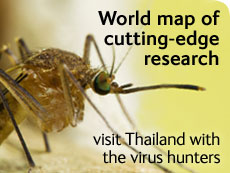Disease
Museum scientists study a range of diseases particularly tropical ones, from well-known viruses, such as Dengue and yellow fever, through to lesser known parasites like the common liver fluke. They also examine the organisms that host dangerous parasites before they are passed on to humans.
By learning more about how diseases spread and enter the human body, we may be able to diagnose and treat them more effectively in the future. Explore the species that help Museum scientists to study tropical diseases below.
-

Wohlfahrtia magnifica (Wohlfahrt’s wound myiasis fly) - 07/02/2010
Wohlfahrtia magnifica is a parasitic species of fly that can bring pain and suffering to its warm-blooded hosts, which include humans. Despite taking just five years to colonise Crete there is no current legislation regarding the control of this species. Find out more about Wohlfahrtia magnifica.
-

Anopheles dirus - 19/11/2010
Anopheles dirus is 1 of a number of mosquito species that transmits malaria - a disease that currently affects over 200 million people worldwide. It thrives in almost any fresh water, from a well to a muddy footprint, and has quickly adapted to new habitats created by human activity. Find out more about this blood-sucking insect and how analysing its genetic makeup might help scientists to control malaria.
-

Anopheles janconnae - 21/02/2010
Find out more about Anopheles janconnae, a species of mosquito that transmits malaria to people, discovered in Roraima in Brazil.
-

Anthosoma crassum - 04/03/2010
Anthosoma crassum is a copepod crustacean and a parasite of fish, particularly sharks. Find out more about how Anthosoma crassum feeds on the tissues and blood of its hosts.
-

Ascaris lumbricoides (giant roundworm) - 15/07/2010
Ascaris lumbricoides is a parasitic worm. It causes the tropical disease ascariasis in humans. Over a billion people worldwide are infected with ascariasis. Find out more about this giant worm and what Museum scientists are doing to help control its spread.
-

Biomphalaria choanomphala - 01/04/2010
Find out more about the distribution and life history of Biomphalaria choanomphala and how research by Museum scientists on these little freshwater snails could help control and treat the intestinal disease schistosomiasis.
-

Bulinus globosus - 06/06/2010
Bulinus globosus is common freshwater snail known from Africa and some some Indian Ocean islands. It is a hermaphrodite capable of self-fertilisation and is a host for several parasitic species. Find out more about Bulinus globosus.
-

Bulinus truncatus - 31/07/2010
Freshwater snails in the genus Bulinus are exceptionally important in Africa as carriers of disease. Species including Bulinus truncatus act as a host for the parasitic worm that causes schistosomiasis - a disease that currently affects 164 million people worldwide. Find out more.
-

Carnus hemapterus - 25/06/2010
The bird fly Carnus hemapterus Nitzsch is a parasite of nestling birds. After locating the host, adult flies loose their wings and start sucking the blood of the nestlings. The females lay their eggs in the nest, where the larvae then develop feeding on organic nest material. Find out more about Carnus hemapterus
-

Cristatella mucedo - 27/09/2010
You might mistake this amazing creature for a caterpillar, but Cristatella mucedo is an invertebrate that is comprised of tiny units called zooids with tentacular feeding crowns that collectively form a large colony. Find out how the caterpillar-like colony takes shape and provides a microhabitat for numerous other species.
-

Fasciola hepatica (common liver fluke) - 09/01/2010
Fasciola hepatica (the common liver fluke) infects the livers of a range of mammals, including man. Find out more about this parasitic worm and why it is proving difficult to control.
-

Haematomyzus elephantis - 15/06/2010
Haematomyzus elephantis, commonly known as the elephant louse, lives and feeds on the skin of African and Asian elephants. It can only survive on elephants. The elephant population can decline from an onslaught of the elephant louse. Find out more about Haematomyzus elephantis.
-

Hymenolepis microstoma - 17/10/2010
Hymenolepis microstoma is a tapeworm parasite of mice and beetles that has been studied in the laboratory for over 50 years. Like all tapeworms, it has no mouth or gut, and feeds by absorbing nutrients in the host’s intestine. Explore the complexities of its reproductive cycle and discover how it provides a model for scientists to explore the biology and genetics of medically important tapeworms.
-

Ixodes ricinus - 07/11/2010
Ixodes ricinus, like other ticks, is a blood-sucking ectoparasite. It lives on a range of back-boned animals including humans and is well-known as a transmitter of Lyme disease. Tiny sensory hairs on its legs and toothed mouthparts make this tick remarkably well adapted to finding and sticking with its host. Discover more about the gripping lifestyle of this tick and the diseases it can spread.
-

Microcystis aeruginosa (cyanobacteria) - 17/07/2010
Microcystis aeruginosa is a green bacterium. Unusually for bacteria it contains chlorophyll - a green pigment more common to plants - that allows it to produce oxygen via photosynthesis. It can grow rapidly over pond surfaces causing ‘blooms’ that are harmful to humans and animals. Find out more.
-

Pediculus humanus (head or body louse) - 08/05/2010
Find out more about Pediculus humanus, a human louse that is an ectoparasite of the human head or body. The head louse variant is common in the western world. The body louse variant can carry typhus and was responsible for hundreds of millions of deaths up until the early nineteen hundreds.
-

Phlebotomus papatasi - 24/05/2010
This tiny sandfly, just 3mm long, plays a key role in a number of human diseases thanks to the blood-sucking behaviour of the female flies. They are responsible for transmitting Leishmania parasites to humans from infected animals, causing cutaneous leishmaniasis, and are also vectors for certain viruses that cause fevers. Find out more about Phlebotomus papatasi.
-

Plasmodium falciparum - 31/08/2010
Plasmodium falciparum is a microscopic parasite transmitted by Anopheles mosquitoes that infects humans. P. falciparum is the commonest and most deadly of all species that cause malaria. Find out how it is transmitted between humans and mosquitoes and what Museum scientists are doing to help control its spread.
-

Schistosoma mansoni (trematode flatworm) - 21/01/2010
This trematode flatworm is one of the major causes of schistosomiasis, a widespread disease that damages internal organs and affects millions of people worldwide. Find out more about Schistosoma mansoni, its lifecycle and how it can cause schistosomiasis.
-

Scopolia carniolica Jacq - 02/08/2010
Scopolia carniolica Jacq. is a species of hallucinogenic plant that grows in the mountainous regions of south-eastern Europe. Its underground stems were used in many Slavic cultures to prepare magical beverages and love potions. Discover why this mysterious plant has, for centuries, mesmerized both folklore and science.
-

Simulium yahense ‘Bioko’ - 17/11/2010
The Bioko blackfly was first described by Museum researcher Rory Post. It is one of several blackflies capable of transmitting a parasitic worm that causes the disease onchocerciasis, or river blindness. The disease affects 18 million people in Africa. Discover how an eradication programme proposed by Museum researchers has successfully wiped out the Bioko blackfly.
-

Suricata suricatta (meerkat) - 10/12/2010
Meerkats are small, sociable mammals which are found across southern Africa. They live in family groups called mobs where individuals co-operate to rear their young, protect against predators and defend their territory. Explore the intricacies of their social interactions and discover when young males form ‘roving parties’, what they eat and how they defend themselves.
-

Xenopsylla cheopis (plague flea) - 28/07/2010
This species of flea is famous for carrying bubonic plague between rodents and humans. It was first described by Nathaniel Charles Rothschild in 1903. He found it amongst dead fleas in Cairo after an outbreak of bubonic plague. The specimens described by Rothschild are here in the collections at the Museum. Discover the power behind the flea’s jump and how it wreaks havoc on humans.
-

Gyrostigma rhinocerontis (rhinoceros bot fly) - 15/12/2010
The rhinoceros bot fly, Gyrostigma rhinocerontis is an endangered species. It depends on rhinos for its survival, and as rhino numbers decline, so too will this fly. The adult fly is the largest in Africa and lives only for a few days, but its larvae spend months developing in the rhino’s stomach. Find out more about the lifecycle of this parasitic fly.
-

Nakiwogo virus - 15/02/2010
Nakiwogo virus is a flavivirus that was discovered in Uganda by Museum scientists. Many flaviviruses infect humans, usually through the bite of an infected mosquito. Find out more about this newly-discovered virus.


